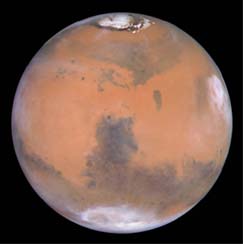Mars

|
 The Red Planet features ice caps of carbon dioxide and water, a volcano 15 miles high (Olympus Mons), a canyon 3,000 miles long and 4 miles deep (the great rift valley, Valles Marinerus), and dry river channels. Many such features were explored in 1971-72 by the Mariner-9 craft. The later Viking landers performed surface tests, looking for evidence of life. Perhaps Mars, now locked in an ice age, once had a denser atmosphere and liquid water on its surface. But NASA's two Viking landers (1976) found no life.
|
Mars Concepts
Solar System Illustration
Solar System Concepts
| HyperPhysics********** Astrophysics | R Nave |

